
Michael Laithangbam is a senior writer & editor at ProProfs with over 12 years of experience in enterprise software and eLearning.
Learn about Our Editorial Process Author & Editor at ProProfs Updated: 22 Jul, 2024
Improper training can cost your business millions of dollars per year per 1,000 employees!
Let that sink in to understand why training evaluations are necessary.
Evaluations act as a checkpoint to measure and analyze whether employee training programs achieve the intended objectives. In other words, they assess what’s working and what’s not so that you can fix it on time. Without a solid evaluation system, you won’t be able to measure training effectiveness.
Since you invest a great deal of time, human labor, and other resources to deliver training, you would certainly want to know the training ROI.
Luckily, there are several training evaluation methods and tools that you’ll discover in this post. Along with this, you’ll learn the benefits of assessing training effectiveness.
Make the most of this essential aspect in every training session by understanding all the techniques and metrics.
If you’re wondering how to evaluate training programs, continue reading to find out more on the topic.
Watch: H ow to Analyze Training Course Results
Training evaluation is a systematic approach that instructors and training departments take to measure the effectiveness of an employee training program. Through evaluations, you can easily measure
If necessary, you can improve your training programs based on the information gathered through such evaluations. The outcome of a training evaluation should show you whether the time, money, and effort you’ve spent on it gives you the expected return on investment.
To help you understand the concept better, here’s a real-life example of an international company banking on a learning management system (LMS) to identify problems faced by its learners and improve the exam system.
Thermo Fisher Scientific is a world leader in supplying scientific instrumentation, reagents, consumables, and software and services. It employs around 37,000 employees and serves pharmaceutical companies, hospitals, clinical diagnostic labs, universities, and research institutions.
The company needed to provide training to its global employees and using an LMS they were able to automatically grade nearly 600 exams. Auto generated statistics helped the company see the questions that people had trouble with, which allowed finer gradation of training.
To understand the different ways such evaluation can help you improve your training programs, hop to the next section.
Before you get to learn how to evaluate training effectiveness, let’s understand the why of it.
There are scores of reasons to run training evaluations. They bring significant benefits to organizations, including insights into training effectiveness. Some of the top ones are:
Post-training feedback from participants, which forms an integral part of training evaluations, can give you an idea of how they find your training courses. If learners don’t score on certain topics or the dropout rate is high, it may be because the course is difficult. You can consider revising those sections to improve scoring and completion rates.
An in-depth analysis of training performance shows you whether you achieve cost-efficiency. Ideally, the outcomes of a training program should be worth all the resources allocated to planning and executing it.
By evaluating corporate training program effectiveness, you’re ensuring that participants undergo needs-based learning to address all the gaps in their competency. Based on a training result analysis, you can deliver the right training so that learners can learn in the best way.

Since an evaluation of training programs basically measures their effectiveness, it can give you a clue about future employee performance and productivity. Employee performance, in turn, has a direct effect on business performance. So, the more effective a training program, the better it is for your business.
Timing in life is everything.
There are two occasions during which you can conduct online training evaluations. They are before you finally roll out a program and another right after it. Let’s look at them in detail.
This evaluation serves as a discovery phase of any potential issues with your training so that you can fix them on time. For this, you can run a pilot test of your courses and assessments with a sample audience before you share them with the rest of the learners.
This will tell you whether the training creates the intended impact on participants. You can also let subject-matter experts review your training program to catch loopholes.
You can conduct this evaluation after learners have completed the training. It can be in the form of quizzes, surveys, and other insightful tests.
The idea is to get the necessary feedback from course participants on how they find the training, which module they find challenging/difficult, which areas of a course they are abandoning most or scoring poorly in, what’s their opinion on the instructors, and what suggestions they would like to share for a better experience.
This evaluation can help you make improvements in your programs.
As you can see, both these forms of evaluation can help you at different points in time. So, it makes sense to leverage both of them.
There are many methods to evaluate training effectiveness. Each of them has its own formula developed by training and education experts. Which one you use depends on your preference and what you think works best for you and your teams.
It is the most widely used training evaluation model developed by Donald Kirkpatrick. It follows four levels to determine the effectiveness of a training program. They are:
It evaluates how learners react to the training. The evaluation is generally done after training to find out their satisfaction with the learning experience and how they rate an overall program.
At this level, learners are evaluated on how much they’ve learned during the training. To arrive at a conclusion, training managers compare the participants’ knowledge and skills before and after training.
Similar to the second level, this level checks whether there is any noticeable change in learners’ behaviors following the training. It observes whether they implement what they learned during the training in their job roles.
The last level evaluates the measurable results of a training program or the business impact it creates. It measures efficiency, performance, productivity, and customer satisfaction.
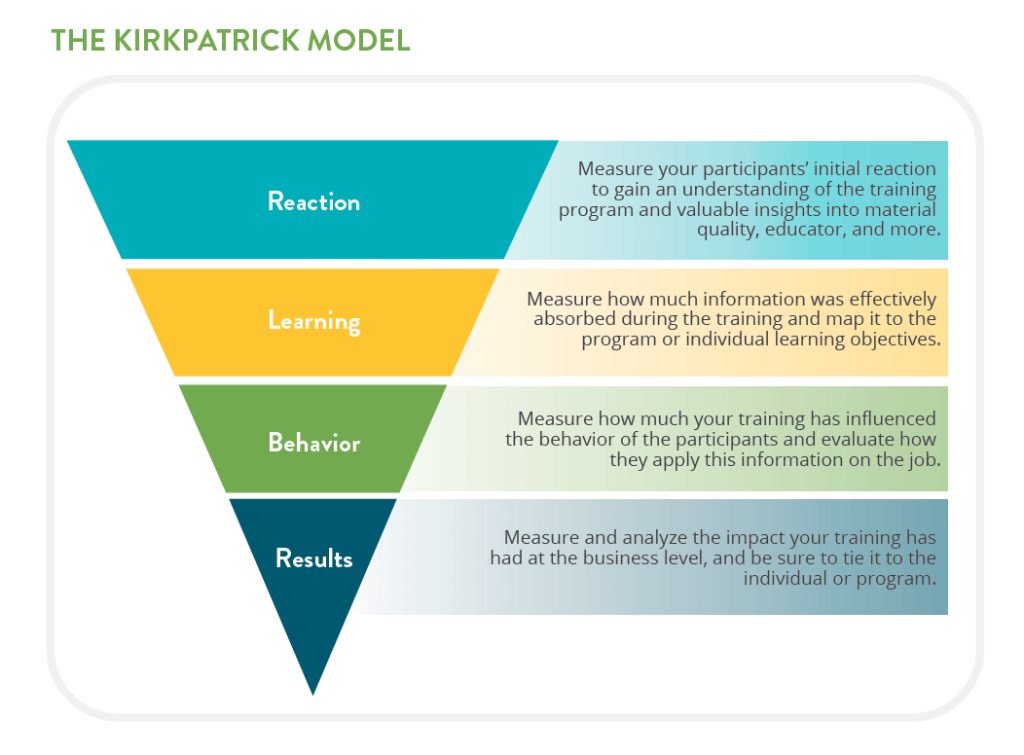
Kaufman’s model of evaluation can be another helpful evaluation method in your quest for how to evaluate training programs effectively. It is more or less similar to the Kirkpatrick model but comes with some extra steps.
Step 1a: It measures the resources invested into a training program to support and sustain it.
Step 1b: It assesses learners’ response to or the acceptance level of training. The Kirkpatrick model calls it learners’ reaction.
Step 2: This step evaluates whether you’ve met your learning objectives to ensure learners acquire the necessary knowledge and skills.
Step 3: Similar to Kirkpatrick’s third level, it measures whether employees apply their new knowledge and skills to their job.
Step 4: It measures the impact of learning at the macro level or on business as a whole, such as cost reduction and increased profitability.
Step 5: The last step assesses the effect of a training program on society or its benefits to clients.
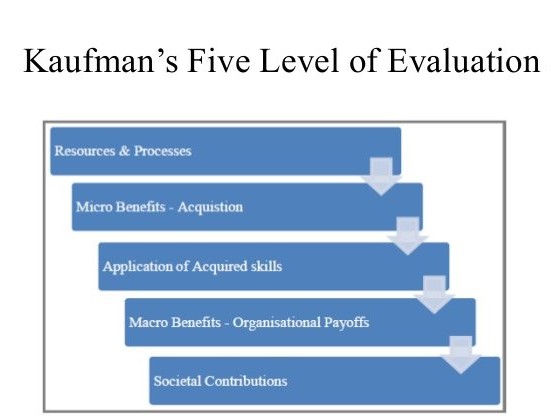
Anderson’s Value of Learning Model entirely focuses on a company’s learning strategy rather than a particular training program. It consists of three stages for determining the best learning strategy based on an organization’s needs.
Stage 1: Evaluation of current training programs against a business’ strategic priorities. For example, if your goal is to achieve more sales, does the training closely align with that target?
Stage 2: This stage measures the contribution of training to strategic business results.
For example, a workplace safety training program intended to reduce unwanted injuries and fatalities can be measured by the actual decrease in the number of these incidents over a period of time.
Stage 3: At this stage, you decide whether the return on investment is worthwhile. If it is not, then you find the most relevant learning approach for your organization.
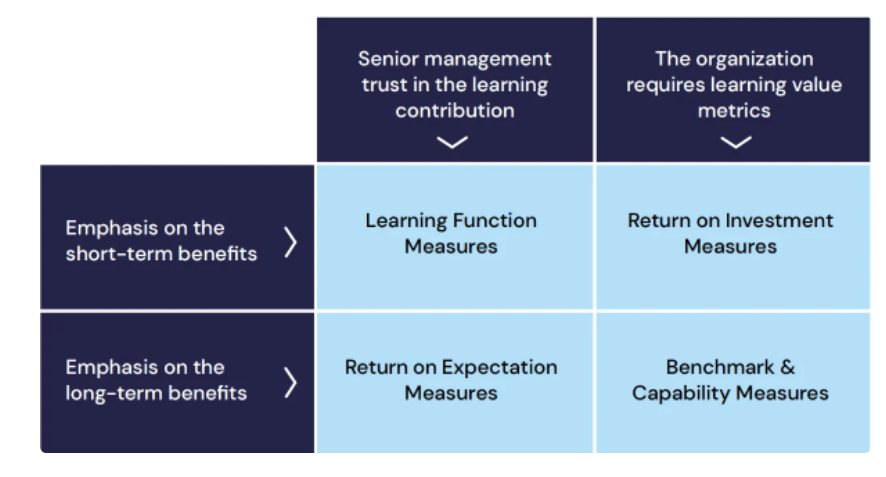
The model measures the following categories:
This model is also similar to the Kirkpatrick model but like Kaufman’s, it comes with an extra step. That final step evaluates a training program’s ROI by measuring the difference between training cost and training results.
Step 1: At this stage, you collect pre-training data to compare it against metrics from the post-training phase.
Step 2: Here, you collect post-training data from various sources, including training participants and training managers.
Step 3: This stage measures the impact of training on key performance areas (KPAs), such as customer satisfaction, profitability, and revenue generation.
Step 4: This compares the value a training program provides with the cost incurred. If the value exceeds the cost, the program is a success. If not, you should identify what didn’t work and improve your training.
Step 5: The final step calculates the return on investment by using the formula:
ROI% = Net program benefits x100
Program cost
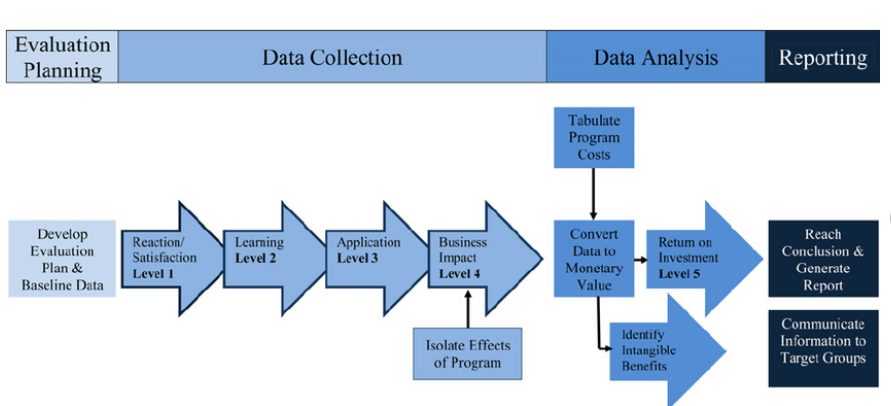
Before you decide to conduct training evaluations, it is important to know what precisely you should measure. The more areas you measure, the more information you will gather to form a fair idea of training effectiveness.
Here are a few metrics you can use to measure your employee training programs:
Learning experience measurement is a must during any learning program. If your learners don’t get a positive experience while interacting with your course content, they will fare poorly in terms of engagement and retention. This means they will not gain the required knowledge and skills.
So, it is important to measure their experience from start to finish to gauge the overall training effectiveness.
This is a priority area in any workplace learning program. At the end of any session, it is natural to expect some improvement in your learners’ practical knowledge and skills compared to the pre-training phase. Make sure you measure any change in their industry knowledge and skills following the training as that would impact their future performance.
Employee empowerment is among the top contributing factors that lead to employee satisfaction. Providing ample opportunities to learn and grow is one of the ways to keep them happy at work. So, you need to measure the satisfaction level of your employees vis-a-vis your training programs.
The greater the satisfaction level, the greater the chances of them staying longer and committed to your company.
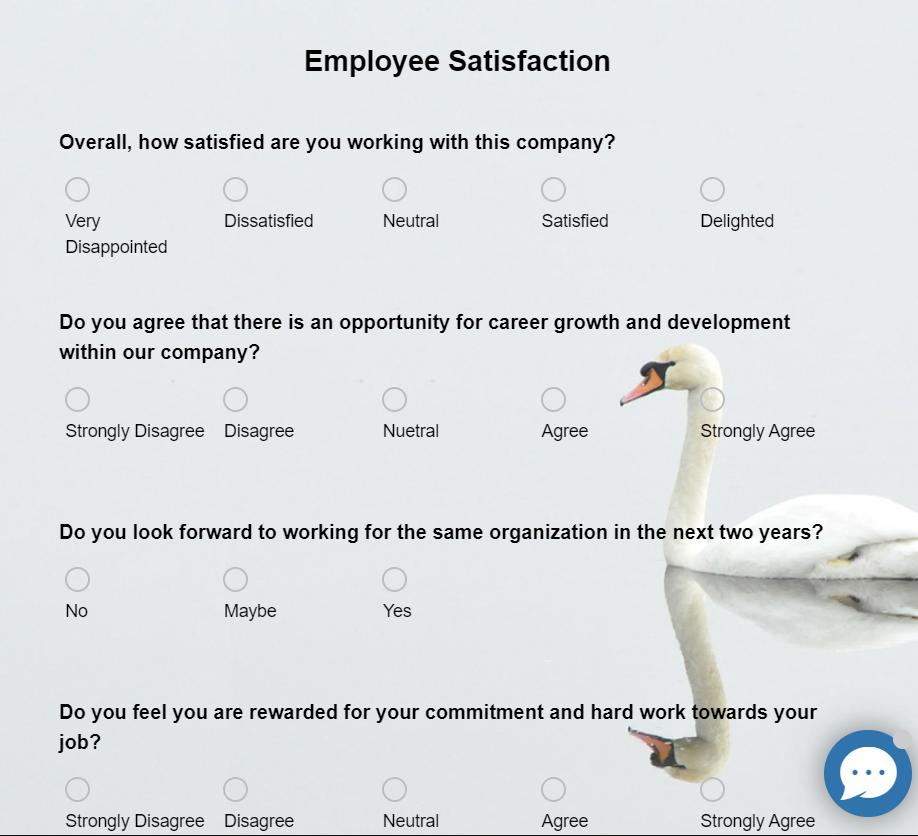
The best way to measure the real benefits of employee training is to measure the improved efficiency and productivity of employees after the training.
For example, you can measure how many tickets your customer support team is able to close before and after undergoing a training program. If the training is impactful, it should reflect positively on the speed, efficiency, and accuracy with which they perform their duties.

Measuring the financial impact of your learning & development initiatives is another crucial step for any business. Your training should be cost-effective and lead to increased sales and revenue. Ideally, it should create a positive economic impact in the form of a rise in business profits and a reduction in costs over time.
The impact of training on a company’s culture is something organizations seldom measure. Through professional training, you can strengthen your culture with the people you hire, serving as a solid foundation.
For example, workplace diversity & sensitivity training is one of the compliance programs that can positively impact a company’s culture. You can deliver the training and measure its outcomes in changed behaviors among employees.
Most LMS software come integrated with a learner tracking and reporting system. This feature provides users with real-time data on:

This way, insightful reports from an LMS provide an overview of learner progress, course completion rate, and pending courses. They also display the engagement level and satisfaction ratings of participants.
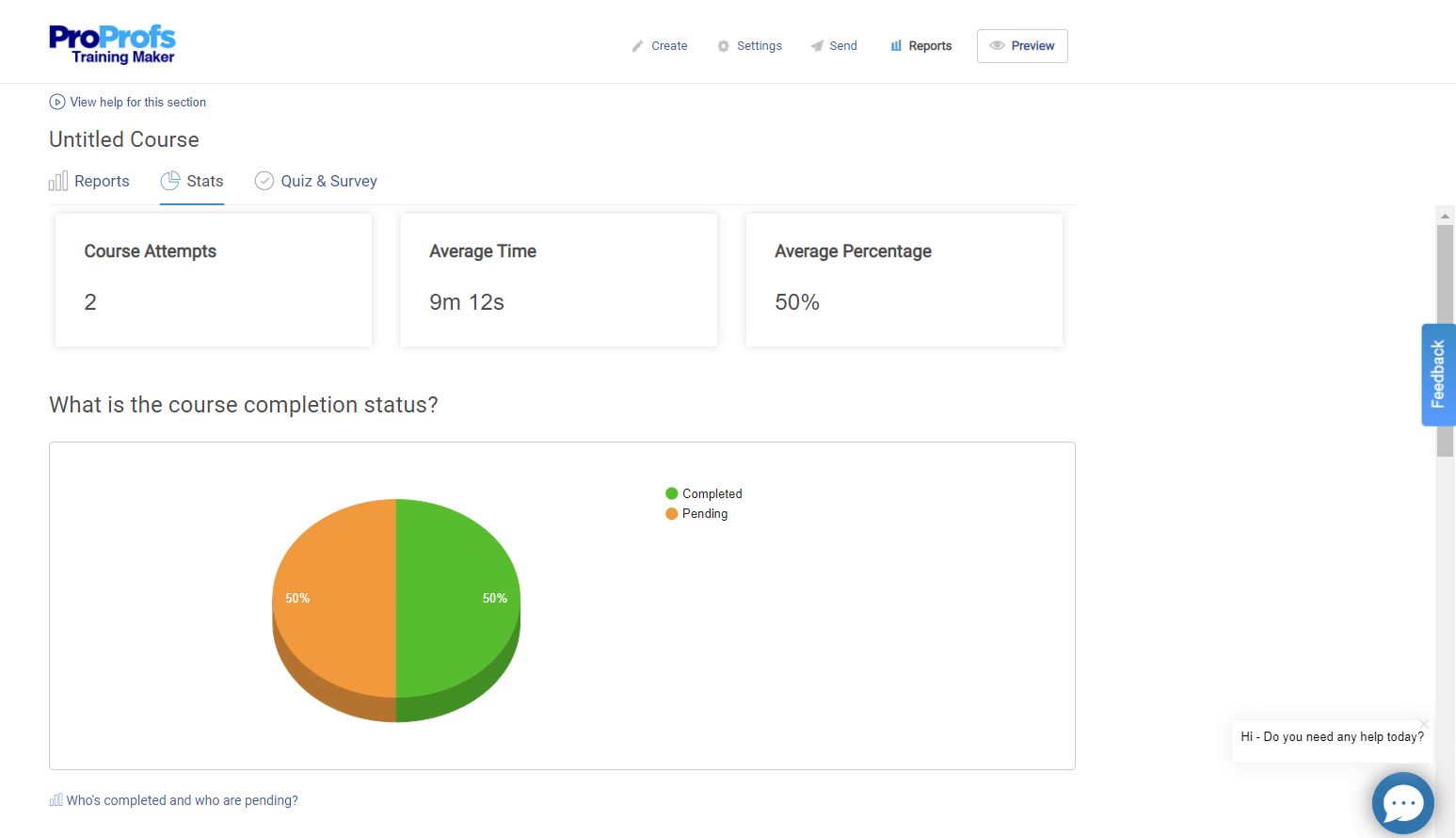
Based on this data, you can take the necessary steps to optimize the learning experiences and maximize training outcomes.
Course reports, in-course quiz reports, and individual and group reports are some of the common report types that a standard LMS supports.
You also get access to the total points and average score a learner or a group obtains in quizzes. This is a significant indicator of training retention among learners.

Some LMS tools allow you to even reset the course progress for a user to let the latter reattempt a course because the certification has expired or for some other reason.
All this makes LMS reporting one of the effective ways to evaluate online training milestones and challenges, continuously improve or overcome them, and use them to your business advantage.
Watch: Case Study – How Tupperware Used ProProfs for Training & Assessment | ProProfs Training Maker
Now that you know what a training evaluation is, the top training evaluation techniques, and some of the metrics you can measure, let’s explore some of the tools you can use for the purpose.
These are basically quiz and survey tools that can help you assess training effectiveness and improve training programs on an ongoing basis.

Quiz Maker by ProProfs is a cloud-based quiz-making tool to create quizzes, tests, and assessments for all use cases, including corporate training. You can easily share these quizzes created on the platform with a person or a group via email, social media, websites, or blogs. ProProfs makes it easy for training departments to create and share scored quizzes to ensure employees understand training objectives.
Choose from 100+ templates and 100,000+ ready questions or start from scratch. You can even add your own branding and adjust the questions and answers to offer a customized experience. The reporting features enable you to keep track of your training results in real-time.
Watch: How to Create an Online Quiz in Under 5 Mins
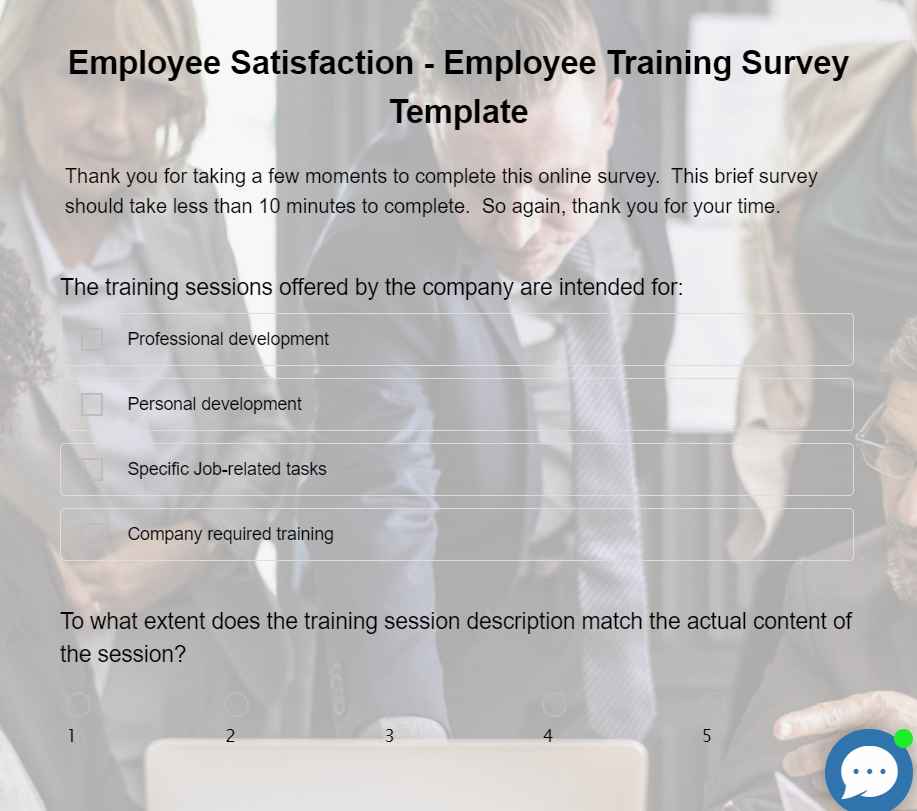
Survey Maker is another software application from ProProfs for creating online surveys such as employee satisfaction surveys. You can create surveys in under 60 seconds by leveraging 100+ expert-designed templates and 100k+ ready-to-use questions. It is versatile enough to let you ask any question, any way you want.
You can add scoring and branching to your survey questions for deep training evaluations, customize the surveys with logo, themes, and colors, and share these on social media via a link or embed on the website.
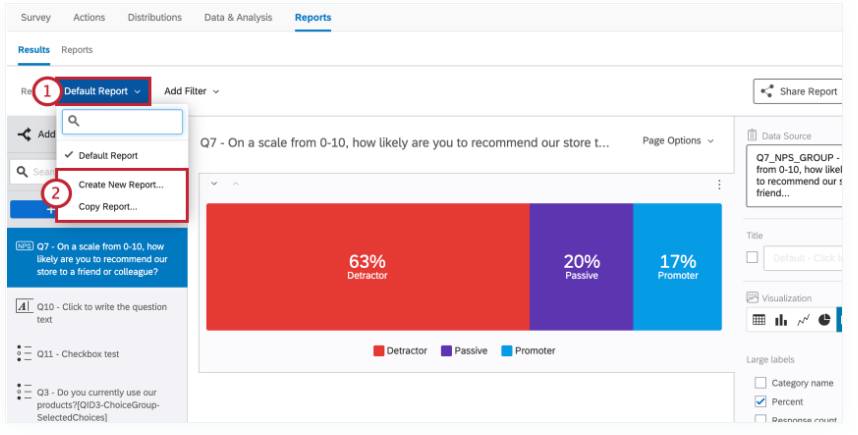
Qualtrics is a cloud platform to create and share surveys, feedback, & polls, and generate reports. You can use it to conduct training evaluations to assess the effectiveness of your training course content and course instructors.
Its training feedback reports present accurate insights with data visualizations and analysis. Distribute your surveys using emails, social media, mobile, web, or your own communication system. Use custom programming languages such as Java, Python, and Node JS to gain more control over your surveys.
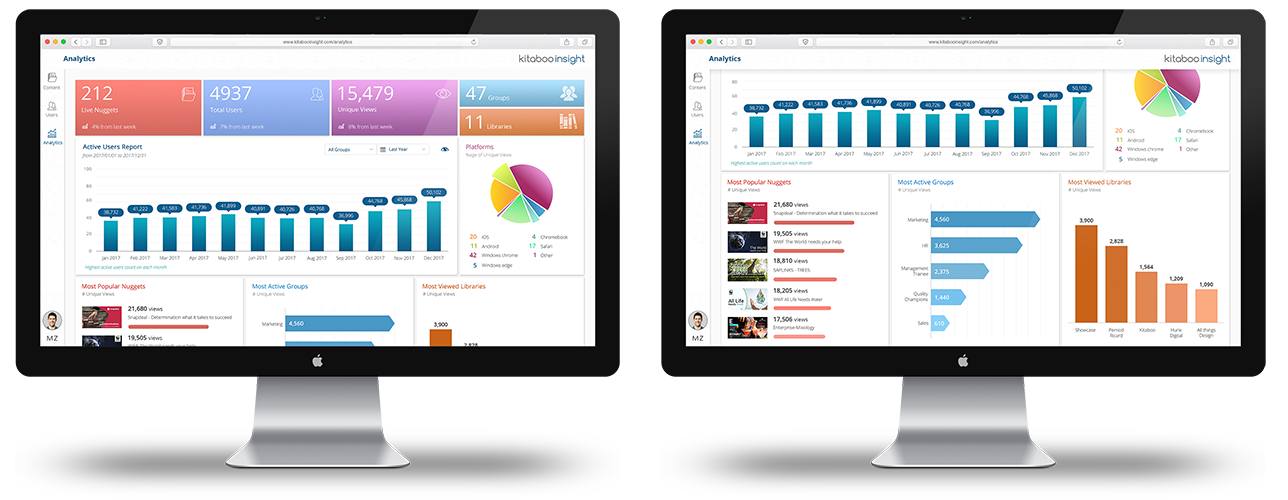
Kitaboo insight is a mobile-first platform for enterprise training and development. Among the features it offers is in-depth analytics. It enables you to track the training delivery patterns, engagement with content, and how your learners consume your courseware.
Training administrators can improvise and personalize the content based on learners’ interest levels and progress. Based on the learning data the tool generates, you can create an improved version of your training content for better results.

SurveyMonkey is one of the most popular online survey software that provides expert-written questions and pre-built survey templates. Enterprises can use them to gather feedback from employees and drive their business forward.
You can pinpoint improvement areas through pre- and post-training surveys. Use the feedback you gathered to assess training effectiveness, evaluate course offerings and instructors, and deliver focused training to develop specific skills. Fast survey creation and easy sharing make it a favorite tool for many.
Now that you know everything about employee training evaluations, it’s up to you to take the next steps to continuously evaluate and improve your programs.
A thorough evaluation will show you how your training is shaping up, the acceptance level, engagement with course content, and impact on behaviors. Once you know what metrics to measure, you can use one of the above methods and tools to easily measure training effectiveness. Based on the data gathered, you can improve your training.
No matter which training type you are deploying, it should be cost-effective, give the desirable ROI, and bring a measurable change in participants’ knowledge and skills. Only then you’ll get the fruits of your labor.
FREE. All Features. FOREVER!
Try our Forever FREE account with all premium features!